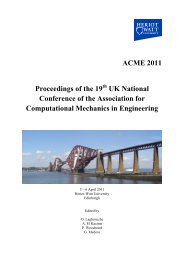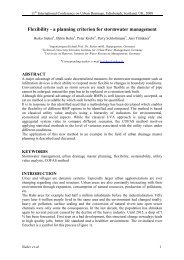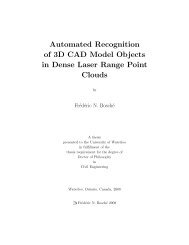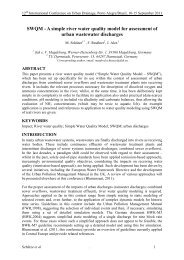Emissions of pollutant loads from combined sewer systems and ...
Emissions of pollutant loads from combined sewer systems and ...
Emissions of pollutant loads from combined sewer systems and ...
Create successful ePaper yourself
Turn your PDF publications into a flip-book with our unique Google optimized e-Paper software.
11 th International Conference on Urban Drainage, Edinburgh, Scotl<strong>and</strong>, UK, 2008<br />
CONCLUSIONS<br />
In conclusion, a general answer, which <strong>sewer</strong> system emits higher pollution <strong>loads</strong> is not<br />
possible. It is extremely dependent <strong>from</strong> the considered substance with its specific properties<br />
<strong>and</strong> resulting behaviour in the <strong>sewer</strong> <strong>systems</strong>. Therefore it is necessary to define<br />
representative decisive criteria for receiving water impairment including a definition <strong>of</strong> the<br />
relevant substance parameters.<br />
Results <strong>of</strong> the pollution load simulation for the <strong>combined</strong> <strong>sewer</strong> system show that emissions<br />
<strong>from</strong> CSOs are significant for certain substance parameters. This finding applies especially to<br />
contaminants that are removed efficiently WWTP, such as estradiol. In this cases reduction<br />
measures should consider discharges out <strong>of</strong> the WWTP <strong>and</strong> the CSO.<br />
Nonetheless, is important to extend the data base on the amount <strong>of</strong> substances, especially<br />
organic <strong>pollutant</strong>s in order to verify these first calculated results. These measurements are<br />
strongly recommended for the <strong>combined</strong> <strong>sewer</strong> system <strong>and</strong> for the CSOs in particular. Beside<br />
<strong>of</strong> the introduced substances further compounds (e.g. surfactants, other substances out <strong>of</strong><br />
personal care products, further pharmaceuticals, herbicides, flame retardants) should be taken<br />
into account.<br />
REFERENCES<br />
ATV-DVWK IG-5.4 (2002). Endokrin wirksame Substanzen in Kläranlagen – Vorkommen, Verbleib und<br />
Wirkung. (Endocrine disruptors in waste water treatment plants – occurrence, distribution <strong>and</strong> effects).<br />
Working document <strong>of</strong> the working group IG-5.4 <strong>from</strong> the German Water Association, DWA, Hennef,<br />
Germany.<br />
Birkett, J.W.; Lester, J.N. (2003). Endocrine Disruptors in Wastewater <strong>and</strong> Sludge Treatment Processes. Lewis<br />
Publishers, CRC Press, Florida, USA.<br />
Brombach, H.; Weiss, G.; Fuchs, S. (2005). A new database on urban run<strong>of</strong>f pollution: comparison <strong>of</strong> separate<br />
<strong>and</strong> <strong>combined</strong> <strong>sewer</strong> <strong>systems</strong>. Wat. Sci. Tech., 51, (2), 119-128.<br />
Clara, M.; Strenn, B.; Gans, O.; Martinez, E.; Kreuzinger, N.; Kroiss, H. (2005). Removal <strong>of</strong> selected<br />
pharmaceuticals, fragrances <strong>and</strong> endocrine disrupting compounds in a membrane bioreactor <strong>and</strong><br />
conventional wastewater treatment plants. Water Research, 39, (19), 4,797-4,807.<br />
EC (European Commission) (2006). Proposal for a directive <strong>of</strong> the European parliament <strong>and</strong> <strong>of</strong> the council on<br />
environmental quality st<strong>and</strong>ards in the field <strong>of</strong> water policy <strong>and</strong> amending directive 2000/60/EC.<br />
Gross, B; Montgomery-Brown, J; Naumann, A; Reinhard, M (2004). Occurrence <strong>and</strong> fate <strong>of</strong> pharmaceuticals<br />
<strong>and</strong> alkylphenol ethoxylate metabolites in an effluent-dominated river <strong>and</strong> wetl<strong>and</strong>. Environmental<br />
Toxicology <strong>and</strong> Chemistry, 23, (9), 2,074-2,083.<br />
Heberer, T. (2002). Occurrence, fate, <strong>and</strong> removal <strong>of</strong> pharmaceutical residues in the aquatic environment, a<br />
review <strong>of</strong> recent research data. Toxicology Letters, 131, 5-17.<br />
House, M.A.; Ellis, J.B.; Herricks, E.E.; Hvitved-Jacobsen, T.; Seager, J.; Lijklema, L.; Aalderink, H.; Clifforde,<br />
I.T. (1993). Urban drainage - impacts on receiving water quality. Wat. Sci. Tech., 27, (12), 117-158.<br />
Irmer, H. (2006). Chemische Gewässerindikatoren – Prioritäre St<strong>of</strong>fe – Defizite – H<strong>and</strong>lungsbedarf (quality<br />
indicators <strong>of</strong> receiving waters – priority substances – deficits – measures). Workshop <strong>of</strong> the Federal<br />
Environment Agency on the Water Framework Directive held in May 2006 in Berlin, Germany.<br />
Johnson, A.C.; Aerni, H.-R.; Gerritsen, A.; Gibert, M.; Giger, W.; Hyll<strong>and</strong>, K.; Jürgens, M.; Nakari, T.;<br />
Pickering, A.; Suter, M.J.-F.; Svenson, A.; Wettstein, F.E. (2005). Comparing steroid estrogen, <strong>and</strong><br />
nonylphenol content across a range <strong>of</strong> European sewage plants with different treatment <strong>and</strong><br />
management practices. Water Research, 39, (1), 47-58.<br />
Joss, A.; Zabczynski, S.; Göbel, A.; H<strong>of</strong>fmann, B.; Löffler, D.; McArdell, C.S.; Ternes, T.; Thomson, A.;<br />
Siegrist, H. (2006). Biological degradation <strong>of</strong> pharmaceuticals in municipal wastewater treatment:<br />
proposing a classification scheme. Water Research, 40, (8), 1,686-1,696.<br />
Makepeace, D.K.; Smith, D.W.; Stanley, S.J. (1995). Urban stormwater quality: Summary <strong>of</strong> contaminant data.<br />
Critical Reviews in Environmental Science <strong>and</strong> Technology, 25, (2), 93-139.<br />
8 Welker













